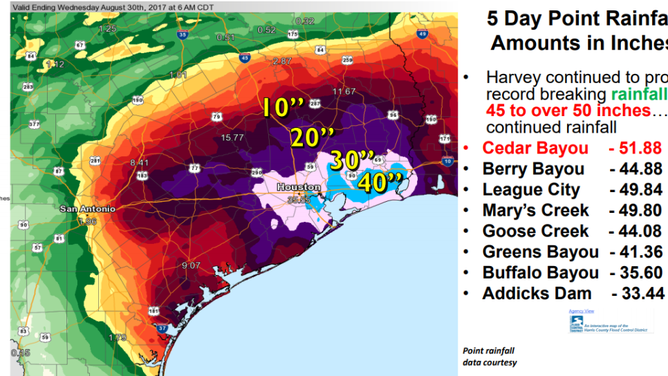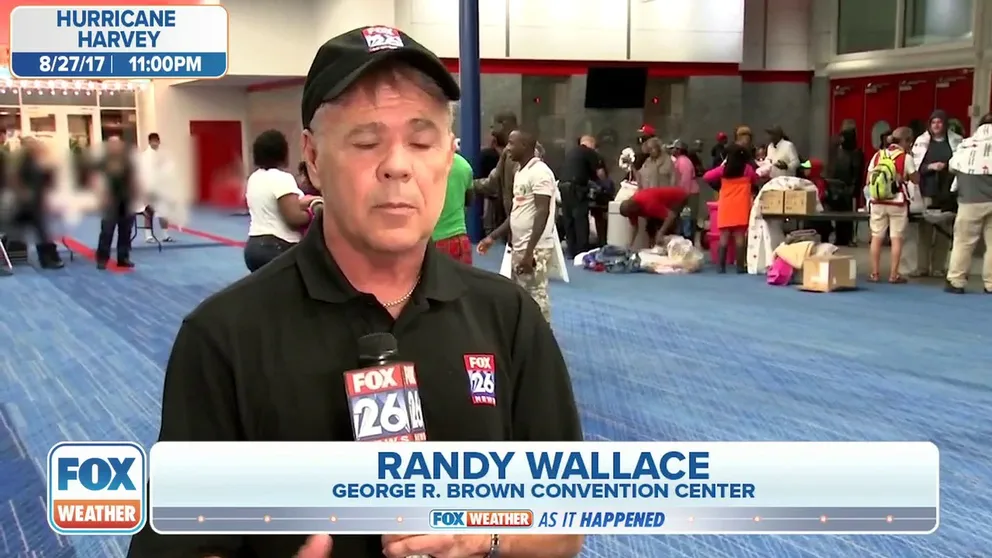What it was like to not only live through but also cover Hurricane Harvey
A Houston-based meteorologist gives his perspective of the catastrophic 2017 storm.
FOX Weather: As It Happened
A look back at Hurricane Harvey's fury from 2017.
Five years ago, the Texas Gulf Coast was bracing for what all the forecasts showed was a powerful hurricane that would linger in the region for days and cause massive flooding. That storm was named Harvey.
Before the storm
I remember several days before, maybe even a week, our chief meteorologist at the television station where I worked as a senior digital editor was talking about a major storm that we need to be watching. As the storm gained strength and inched closer to the coast, he was telling us to prepare for days of torrential rain. Some of the forecast models showed as much as 70 inches, others showed as little as 20 inches. Either way, this was going to be one for the record books.
Landfall
It was about 10 p.m. Friday, Aug. 25, 2017, when Harvey slammed into San Jose Island, Texas as a Category 4 storm with winds of more than 130 mph. Coastal towns in the area were left devastated by wind damage. I remember one of our reporters on the coast that night standing in the shadow of a building to protect him from the winds, but even that wasn’t enough to keep him from getting whipped around.
Tornadoes, then the deluge
By the next morning, Harvey had moved inland a few dozen miles. The forecast for Houston was for scattered storms, some of which could become severe. By Saturday afternoon, I headed into the station to prepare for coverage. By late afternoon, we had tornadoes reported across the area, mainly north of the city. Some damage was reported before the storms died off after sunset. So far, no flooding rains, so I headed home to prepare for the next day.
As I was headed home, some of the heaviest rain I have ever experienced began. Roads quickly flooded, which isn’t unusual in Houston when tropical rains happen. What was unusual is that the deluge didn’t stop. It just kept raining, and raining, and raining. It was more than an hour before it let up. By then, the storm drain in the parking lot of my apartment building was full. Drains in the grass were full. Sediment was building up around the edges of the mini-pond that had formed inches from the front of my car.
Here’s one of the Facebook Live videos I posted after the first round of rain.
Eventually, the drains would catch up and that first round of rain was able to head to Galveston Bay via the system of bayous that Houston has developed to deal with just such a problem.
A couple of hours later, we got another wave of torrential rain. Another followed a couple of hours after that. Still, nothing major was happening. I headed to sleep because I was supposed to be headed into work about 6 a.m. Sunday.
Wake-up call
About 3 a.m., my boss calls to wake me up.
"You should head to the station now," he said with a clear note of urgency in his voice. "The roads are getting really bad and you may not be able to make it in later."
I threw on some clothes, grabbed the bag that I had packed and jumped in the car. The roads weren’t bad in west Houston, where I lived, but I figured the freeways might be the safest way to get there. I jumped on the tollway next to my apartment. I was able to get to about two exits away from the station before I saw water covering the road. I did what all of us meteorologists tell people to do, "Turn around. Don’t drown." This required me to back up the exit ramp to get back on the freeway. I tried the next exit and the next. Water was everywhere. I called my boss and told him I was going to go back home and work from there until the roads improved.
That wouldn’t be until Sunday night.
Sleeping at work
Once I was at the station, I think I ended up working something like nearly 14 hours straight before I was able to get some sleep in one of the sales offices on the second floor, where we had an air mattress blown up. I’d repeat that three more times before I was able to get back home and into my own bed. Luckily, our station had showers installed for just this type of scenario — people stuck at work for days because of the weather.
Calls for help
One of the most vivid memories I have of Hurricane Harvey is the desperate calls for help we received at the television station as floodwaters inundated neighborhoods in the middle of the night. It wasn’t just telephone calls. People were sending us messages on social media. They were looking for a way out of their homes as waters starting rising. Some people said they were climbing into the attic to get away from the steadily increasing water level. Others said they had to cut a hole through their attic’s ceiling in order to get onto the roof.
Neighborhoods lost power as waters short-circuited the electric grid. The cellphone was the only way for some people to get information about what was happening or ask for people to come help.
Neighbors helping neighbors
I’ve never seen anything quite like this. Sure, I’ve seen people giving their neighbors shelter when their home burned down or cooking meals for families grieving someone’s loss. This was on a different scale entirely.
As flooding commenced, entire neighborhoods — house after house, street after street — had several feet of water covering them. Scores of people had to grab what they could and escape before their homes were underwater. The problem is, they couldn’t get out of their neighborhood once they got out of their home.
Calls for help went out over social media. Within hours, Houstonians hitched up their fishing boats, kayaks and rafts. Scenes of these boats skirting across the floodwaters, bringing people to safety became the norm during Harvey. So did images of people helping elderly residents into trucks that were tall enough to navigate the flooded streets.
50 inches of rain
Before it was all over — about four days later — more than 50 inches of rain had fallen on the Houston area. That’s just shy of the average rainfall for an entire year in Houston. At one point, nearly seven inches of rain was falling per hour. The storm set records left and right. Some of those records had stood since the 1880s.

This map shows how much rain fell over the Southeast Texas region during the five days that Hurricane Harvey was moving through the region.
(NWS Houston/Galveston)
More than 60 deaths
A total of 68 people died as a result of Hurricane Harvey. A little more than half of those who died were in Harris County, the home of Houston. All but three of those deaths were from flooding.
